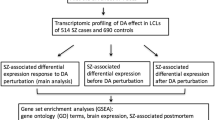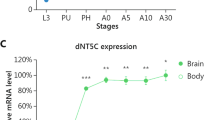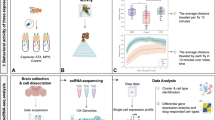Abstract
Rationale
Lithium and valproate (VPA) are drugs used in the management of bipolar disorder. Even though they reportedly act on various pathways, the transcriptional targets relevant for disease mechanism and therapeutic effect remain unclear. Furthermore, multiple studies used lymphoblasts of bipolar patients as a cellular proxy, but it remains unclear whether peripheral cells provide a good readout for the effects of these drugs in the brain.
Objectives
We used Drosophila culture cells and adult flies to analyze the transcriptional effects of lithium and VPA and define mechanistic pathways.
Methods
Transcriptional profiles were determined for Drosophila S2-cells and adult fly heads following lithium or VPA treatment. Gene ontology categories were identified using the DAVID functional annotation tool with a cut-off of p < 0.05. Significantly enriched GO terms were clustered using REVIGO and DAVID functional annotation clustering. Significance of overlap between transcript lists was determined with a Fisher’s exact hypergeometric test.
Results
Treatment of cultured cells and adult flies with lithium and VPA induces transcriptional responses in genes with similar ontology, with as most prominent immune response, neuronal development, neuronal function, and metabolism.
Conclusions
(i) Transcriptional effects of lithium and VPA in Drosophila S2 cells and heads show significant overlap. (ii) The overlap between transcriptional alterations in peripheral versus neuronal cells at the single gene level is negligible, but at the gene ontology and pathway level considerable overlap can be found. (iii) Lithium and VPA act on evolutionarily conserved pathways in Drosophila and mammalian models.






Similar content being viewed by others
References
Allagui MS, Vincent C, El feki A, Gaubin Y, Croute F (2007) Lithium toxicity and expression of stress-related genes or proteins in A549 cells. Biochim Biophys Acta 1773:1107–1115
Andreopoulos S, Wasserman M, Woo K, Li PP, Warsh JJ (2004) Chronic lithium treatment of B lymphoblasts from bipolar disorder patients reduces transient receptor potential channel 3 levels. Pharmacogenomics J 4:365–373
Angst J (1998) The emerging epidemiology of hypomania and bipolar II disorder. J Affect Disord 50:143–151
Baptista T, Murzi E, Hernandez L, Burguera JL, Burguera M (1991) Mechanism of the sex-dependent effect of lithium on body weight in rats. Pharmacol Biochem Behav 38:533–537
Basselin M, Kim HW, Chen M, Ma K, Rapoport SI, Murphy RC, Farias SE (2010) Lithium modifies brain arachidonic and docosahexaenoic metabolism in rat lipopolysaccharide model of neuroinflammation. J Lipid Res 51:1049–1056
Beghi E, Shorvon S (2011) Antiepileptic drugs and the immune system. Epilepsia 52(Suppl 3):40–44
Benjamini Y, Hochberg Y (1995) Controlling the false discovery rate: a practical and powerful approach to multiple testing. J R Stat Soc Ser B 57:289–300
Berger Z, Ttofi EK, Michel CH, Pasco MY, Tenant S, Rubinsztein DC, O'Kane CJ (2005) Lithium rescues toxicity of aggregate-prone proteins in Drosophila by perturbing Wnt pathway. Hum Mol Genet 14:3003–3011
Boudadi E, Stower H, Halsall JA, Rutledge CE, Leeb M, Wutz A, O’Neill LP, Nightingale KP, Turner BM (2013) The histone deacetylase inhibitor sodium valproate causes limited transcriptional change in mouse embryonic stem cells but selectively overrides Polycomb-mediated Hoxb silencing. Epigenetics Chromatin 6:11
Chetcuti A, Adams LJ, Mitchell PB, Schofield PR (2008) Microarray gene expression profiling of mouse brain mRNA in a model of lithium treatment. Psychiatr Genet 18:64–72
Chiu CT, Wang Z, Hunsberger JG, Chuang DM (2013) Therapeutic potential of mood stabilizers lithium and valproic acid: beyond bipolar disorder. Pharmacol Rev 65:105–142
Colleoni S, Galli C, Gaspar JA, Meganathan K, Jagtap S, Hescheler J, Zagoura D, Bremer S, Sachinidis A, Lazzari G (2014) A comparative transcriptomic study on the effects of valproic acid on two different hESCs lines in a neural teratogenicity test system. Toxicol Lett 231:38–44
da Huang W, Sherman BT, Lempicki RA (2008) Systematic and integrative analysis of large gene lists using DAVID bioinformatics resources. Nat Protoc 4:44–57
Dennis G Jr, Sherman BT, Hosack DA, Yang J, Gao W, Lane HC, Lempicki RA (2003) DAVID: Database for Annotation, Visualization, and Integrated Discovery. Genome Biol 4:P3
Dokucu ME, Yu L, Taghert PH (2005) Lithium- and valproate-induced alterations in circadian locomotor behavior in Drosophila. Neuropsychopharmacology 30:2216–2224
Garnham J, Munro A, Slaney C, Macdougall M, Passmore M, Duffy A, O'Donovan C, Teehan A, Alda M (2007) Prophylactic treatment response in bipolar disorder: results of a naturalistic observation study. J Affect Disord 104:185–190
Gentleman RC, Carey VJ, Bates DM, Bolstad B, Dettling M, Dudoit S, Ellis B, Gautier L, Ge Y, Gentry J, Hornik K, Hothorn T, Huber W, Iacus S, Irizarry R, Leisch F, Li C, Maechler M, Rossini AJ, Sawitzki G, Smith C, Smyth G, Tierney L, Yang JY, Zhang J (2004) Bioconductor: open software development for computational biology and bioinformatics. Genome Biol 5:R80
Geoffroy PA, Bellivier F, Leboyer M, Etain B (2014) Can the response to mood stabilizers be predicted in bipolar disorder? Front Biosci (Elite Ed) 6:120–138
Gibney SM, Drexhage HA (2013) Evidence for a dysregulated immune system in the etiology of psychiatric disorders. J Neuroimmune Pharmacol 8:900–920
Gould TD, Quiroz JA, Singh J, Zarate CA, Manji HK (2004) Emerging experimental therapeutics for bipolar disorder: insights from the molecular and cellular actions of current mood stabilizers. Mol Psychiatry 9:734–755
Halleskog C, Schulte G (2013) WNT-3A and WNT-5A counteract lipopolysaccharide-induced pro-inflammatory changes in mouse primary microglia. J Neurochem 125:803–808
Ichiyama T, Okada K, Lipton JM, Matsubara T, Hayashi T, Furukawa S (2000) Sodium valproate inhibits production of TNF-alpha and IL-6 and activation of NF-kappaB. Brain Res 857:246–251
Jergil M, Forsberg M, Salter H, Stockling K, Gustafson AL, Dencker L, Stigson M (2011) Short-time gene expression response to valproic acid and valproic acid analogs in mouse embryonic stem cells. Toxicol Sci 121:328–342
Jia DD, Zhang L, Chen Z, Wang CR, Huang FZ, Duan RH, Xia K, Tang BS, Jiang H (2013) Lithium chloride alleviates neurodegeneration partly by inhibiting activity of GSK3beta in a SCA3 Drosophila model. Cerebellum 12:892–901
Jones KA, Thomsen C (2013) The role of the innate immune system in psychiatric disorders. Mol Cell Neurosci 53:52–62
Kasuya J, Kaas G, Kitamoto T (2009) Effects of lithium chloride on the gene expression profiles in Drosophila heads. Neurosci Res 64:413–420
Kay G, Sargeant M, McGuffin P, Whatley S, Marchbanks R, Bullock T, Montgomery S, Elliott JM (1994) The lymphoblast beta-adrenergic receptor in bipolar depressed patients: effect of chronic incubation with lithium chloride. J Affect Disord 30:185–192
Kerner B (2014) Genetics of bipolar disorder. Appl Clin Genet 7:33–42
Kilander MB, Halleskog C, Schulte G (2011) Recombinant WNTs differentially activate beta-catenin-dependent and -independent signalling in mouse microglia-like cells. Acta Physiol (Oxf) 203:363–372
Leng Y, Liang MH, Ren M, Marinova Z, Leeds P, Chuang DM (2008) Synergistic neuroprotective effects of lithium and valproic acid or other histone deacetylase inhibitors in neurons: roles of glycogen synthase kinase-3 inhibition. J Neurosci 28:2576–2588
Leonard BE (2001) Changes in the immune system in depression and dementia: causal or co-incidental effects? Int J Dev Neurosci 19:305–312
Li X, Overton IM, Baines RA, Keegan LP, O'Connell MA (2014) The ADAR RNA editing enzyme controls neuronal excitability in Drosophila melanogaster. Nucleic Acids Res 42:1139–1151
Lieb J (2004) The immunostimulating and antimicrobial properties of lithium and antidepressants. J Infect 49:88–93
Maddu N, Raghavendra PB (2015) Review of lithium effects on immune cells. Immunopharmacol Immunotoxicol: 1-15
Marques AH, Cizza G, Sternberg E (2007) Brain-immune interactions and implications in psychiatric disorders. Rev Bras Psiquiatr 29(Suppl 1):S27–S32
McBride SM, Choi CH, Wang Y, Liebelt D, Braunstein E, Ferreiro D, Sehgal A, Siwicki KK, Dockendorff TC, Nguyen HT, McDonald TV, Jongens TA (2005) Pharmacological rescue of synaptic plasticity, courtship behavior, and mushroom body defects in a Drosophila model of fragile X syndrome. Neuron 45:753–764
McColl G, Killilea DW, Hubbard AE, Vantipalli MC, Melov S, Lithgow GJ (2008) Pharmacogenetic analysis of lithium-induced delayed aging in Caenorhabditis elegans. J Biol Chem 283:350–357
Merikangas KR, Akiskal HS, Angst J, Greenberg PE, Hirschfeld RM, Petukhova M, Kessler RC (2007) Lifetime and 12-month prevalence of bipolar spectrum disorder in the National Comorbidity Survey replication. Arch Gen Psychiatry 64:543–552
Mudher A, Shepherd D, Newman TA, Mildren P, Jukes JP, Squire A, Mears A, Drummond JA, Berg S, MacKay D, Asuni AA, Bhat R, Lovestone S (2004) GSK-3beta inhibition reverses axonal transport defects and behavioural phenotypes in Drosophila. Mol Psychiatry 9:522–530
Murray CJ, Lopez AD (1996) Evidence-based health policy—lessons from the Global Burden of Disease Study. Science 274:740–743
Oruch R, Elderbi MA, Khattab HA, Pryme IF, Lund A (2014) Lithium: a review of pharmacology, clinical uses, and toxicity. Eur J Pharmacol 740:464–473
Rapaport MH, Manji HK (2001) The effects of lithium on ex vivo cytokine production. Biol Psychiatry 50:217–224
Schloesser RJ, Martinowich K, Manji HK (2012) Mood-stabilizing drugs: mechanisms of action. Trends Neurosci 35:36–46
Schneider I (1972) Cell lines derived from late embryonic stages of Drosophila melanogaster. J Embryol Exp Morphol 27:353–365
Seelan RS, Khalyfa A, Lakshmanan J, Casanova MF, Parthasarathy RN (2008) Deciphering the lithium transcriptome: microarray profiling of lithium-modulated gene expression in human neuronal cells. Neuroscience 151:1184–1197
Smyth GK (2004) Linear models and empirical Bayes methods for assessing differential expression in microarray experiments. Stat Appl Genet Mol Biol 3: Article3
Sofola-Adesakin O, Castillo-Quan JI, Rallis C, Tain LS, Bjedov I, Rogers I, Li L, Martinez P, Khericha M, Cabecinha M, Bahler J, Partridge L (2014) Lithium suppresses Abeta pathology by inhibiting translation in an adult Drosophila model of Alzheimer’s disease. Front Aging Neurosci 6:190
St Pierre SE, Ponting L, Stefancsik R, McQuilton P (2014) FlyBase 102—advanced approaches to interrogating FlyBase. Nucleic Acids Res 42:D780–D788
Sun X, Young LT, Wang JF, Grof P, Turecki G, Rouleau GA, Alda M (2004) Identification of lithium-regulated genes in cultured lymphoblasts of lithium responsive subjects with bipolar disorder. Neuropsychopharmacology 29:799–804
Supek F, Bosnjak M, Skunca N, Smuc T (2011) REVIGO summarizes and visualizes long lists of gene ontology terms. PLoS One 6:e21800
The Network and Pathway analysis subgroup of the Psychiatric Genomics Consortium (2015) Psychiatric genome-wide association study analyses implicate neuronal, immune and histone pathways. Nat Neurosci 18:199–209
Wang JF, Shao L, Sun X, Young LT (2004) Glutathione S-transferase is a novel target for mood stabilizing drugs in primary cultured neurons. J Neurochem 88:1477–1484
Williams RS, Cheng L, Mudge AW, Harwood AJ (2002) A common mechanism of action for three mood-stabilizing drugs. Nature 417:292–295
Yi J, Zhang L, Tang B, Han W, Zhou Y, Chen Z, Jia D, Jiang H (2013) Sodium valproate alleviates neurodegeneration in SCA3/MJD via suppressing apoptosis and rescuing the hypoacetylation levels of histone H3 and H4. PLoS One 8:e54792
Zhang XZ, Yin AH, Lin DJ, Zhu XY, Ding Q, Wang CH, Chen YX (2012) Analyzing gene expression profile in K562 cells exposed to sodium valproate using microarray combined with the connectivity map database. J Biomed Biotechnol 2012:654291
Zwarts L, Magwire MM, Carbone MA, Versteven M, Herteleer L, Anholt RR, Callaerts P, Mackay TF (2011) Complex genetic architecture of Drosophila aggressive behavior. Proc Natl Acad Sci U S A 108:17070–17075
Acknowledgments
This work was funded by VIB. The authors acknowledge the collaborators of the VIB Nucleomics core for expert support with microarray experiments.
Author information
Authors and Affiliations
Corresponding author
Ethics declarations
Conflict of interest
The authors declare that they have no competing interests.
Additional information
L. Herteleer and L. Zwarts contributed equally to this work.
Electronic supplementary material
Below is the link to the electronic supplementary material.
Suppl. Fig. 1
Toxicity analysis of LiCl (A) Survival analysis of Berlin females using increasing doses of LiCl. (B) Survival analysis of Berlin males using increasing doses of LiCl. (C) Survival analysis of Canton-S females using increasing doses of LiCl. D) Survival analysis of Canton-S males using increasing doses of LiCl. (Logrank tests, * P < 0.05; ** P < 0.01; ***P < 0.001; **** P < 0.0001) We analyzed the effects of LiCl on two different wild type strains (Canton-S and Berlin) to rule out differential effects due to the genetic background. We examined the effects of a concentration range of 10, 15, 20, 25, 30 mM. As LiCl has been reported to be a teratogen, we administered this drug in adult flies (Dokucu et al. 2005). We observed significant decreases in survival for almost all concentrations in both Canton-S and Berlin males. Interestingly, we observed different effects on survival on females of both strains. Berlin females showed a clear increase in survival upon treatment with LiCl. Canton-S females showed to be very unresponsive to the effects of LiCl on survival. Only administration of 30 mM LiCl induced a significant decrease in survival. Based on our results, we decided to use 10 mM LiCl in the subsequent experiments. LiCl has previously been shown to have positive effects on survival in C. elegans in the concentration range that we used (McColl et al. 2008). Interestingly, these positive effects of LiCl on life span involve the downregulation of the homologue of LSD-1 (McColl et al. 2008). We show that treating S2 cells with either LiCl or VPA results in an upregulation of LSD-1 expression. Since the effects of LiCl on lifespan in C. elegans have only been investigated in a single genetic background, it will be interesting to analyze whether there are strain-specific effects as well. In addition, LiCl has been reported previously to have sex specific effects on body weight in rats (Baptista et al. 1991). A short survival study (14 days) in Drosophila did not reveal sex specific effects (Dokucu et al. 2005). In our more extensive study we do find clear sex-dependent effects. (PDF 126 kb)
Suppl. Fig. 2
Toxicity analysis of VPA (A) Survival analysis of Berlin females using increasing doses of VPA. (B) Survival analysis of Berlin males using increasing doses of VPA. (C) Survival analysis of Canton-S females using increasing doses of VPA. (D) Survival analysis of Canton-S males using increasing doses of VPA. (Logrank tests, * P < 0.05; ** P < 0.01; ***P < 0.001; **** P < 0.0001) We analyzed the effects of VPA on two different wild type strains (Canton-S and Berlin) to rule out differential effects due to the genetic background. We examined the effects of a concentration range of 0.5, 1, 3, 5, 10 mM. As VPA has been reported to be a teratogen, we administered this drug after eclosion (Dokucu et al. 2005). We observe a strong decrease in survival upon administration of increasing dosages of the drug. We can observe some variations in responsiveness between both wild type lines. Canton- S flies seem to be more sensitive to the effects of VPA on survival than Berlin flies. Based on our results, we decided to use 1 mM VPA in the subsequent experiments. (PDF 130 kb)
Suppl. Table 1
Significant transcripts in Drosophila S2-cells upon lithium treatment (FDR < 0.05, FC1.3). (PDF 594 kb)
Suppl. Table 2
Significant transcripts in Drosophila S2-cells upon VPA treatment (FDR < 0.05, FC1.3). (PDF 570 kb)
Suppl. Table 3
Enriched GO terms among significantly altered transcripts in Drosophila S2-cells and heads upon lithium and VPA treatment (P < 0.05). Terms in italics represent redundant terms summarized in one main term by making use of REVIGO (Supek et al. 2011). (PDF 84 kb)
Suppl. Table 4
DAVID: Functional Annotation Clustering of significant gene ontology terms (Enrichment >1.3). (PDF 55 kb)
Suppl. Table 5
Overlapping transcripts in Drosophila S2-cells upon lithium or VPA treatment. (PDF 365 kb)
Suppl. Table 6
Significant transcripts in Drosophila heads upon lithium treatment. (PDF 110 kb)
Suppl. Table 7
Significant transcripts in Drosophila heads upon VPA treatment. (PDF 285 kb)
Suppl. Table 8
Overlapping transcripts in Drosophila heads upon lithium or VPA treatment. (PDF 206 kb)
Suppl. Table 9
Overlapping transcripts in Drosophila S2-cells and heads upon lithium treatment. (PDF 50 kb)
Suppl. Table 10
Overlapping transcripts in Drosophila S2-cells and heads upon VPA treatment. (PDF 47 kb)
Rights and permissions
About this article
Cite this article
Herteleer, L., Zwarts, L., Hens, K. et al. Mood stabilizing drugs regulate transcription of immune, neuronal and metabolic pathway genes in Drosophila . Psychopharmacology 233, 1751–1762 (2016). https://doi.org/10.1007/s00213-016-4223-z
Received:
Accepted:
Published:
Issue Date:
DOI: https://doi.org/10.1007/s00213-016-4223-z




